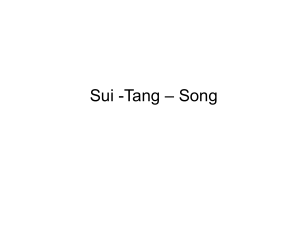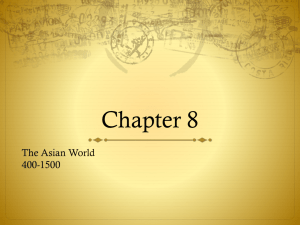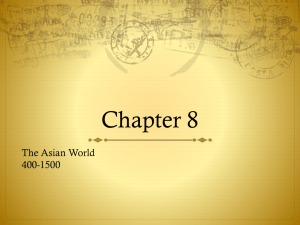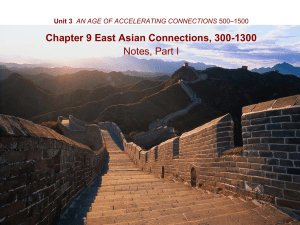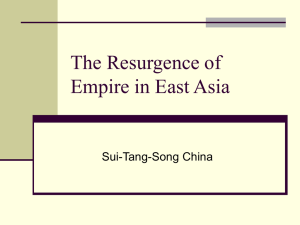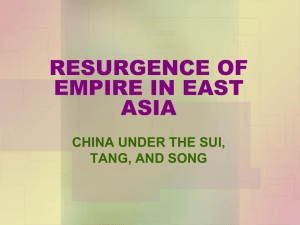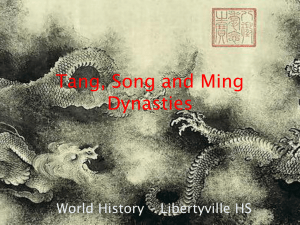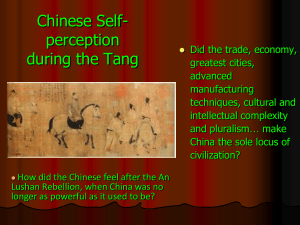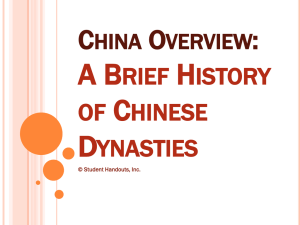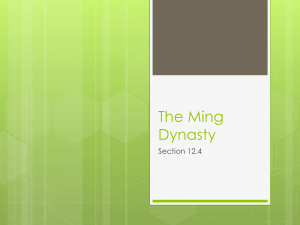Ch. 12 China Tang & Song
advertisement
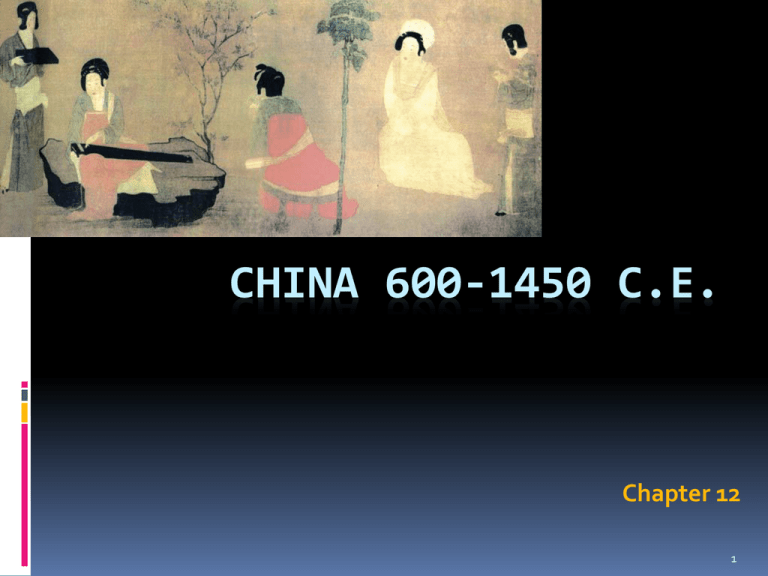
CHINA 600-1450 C.E. Chapter 12 1 Chinese Dynasties 2 Ch.12 Timeline 3 Ch.12 Map Exercise China During the Era of Division, The Sui Dynasty, and the Tang Dynasty 4 Foundations of Sui-Tang Dynasty 589–618 C.E. After the fall of the Han Dynasty there was a long factional struggle 220-589 C.E. Wendi unified China in 589 C.E. known as the Sui Dynasty Used alliances, deception, & warfare Yangdi, killed his father to gain the throne To strengthen his empire made legal & educational reforms Military Defeats & expensive building projects Completion of the Grand Canal, took 5 million people. Projects overwhelmed the people that led to revolts After Yangdi’s death, Li Yuan seized power and founded the Tang Dynasty 5 Grand Canal Beijing to Hangzhou 1,115 miles long Connect several existing canals built by past Dynasties 6 Foundations of Tang Dynasty 618–907 Li Yuan ‘s rapid revival of an empire under the Tang was because of imperial bureaucracy using Confucian ideology Used scholar-gentry to create bureaucracy & check nobility’s power Expanded the Confucian-based examination system Ministry of Rites administered exams, but some officials gained positions via family connections (birth) instead of merit Li Yuan expanded China’s boundaries Afghanistan, Vietnam, Korea, Changan new capital 7 Buddhism Buddhism became fully established in China “Golden Age” Mahayana (Pure-land) founded by Chinese monks Appealed to the Chinese commoners Salvationist variant of Buddhism Offered a refuge from war and turmoil. Elite class Chan (Zen–Japan) variants popular Received a warm welcome at first from Daoists, as they seemed to have much in common They both have priests and monasteries The Leshan Giant Buddha, 233 ft tall begun in 713, completed in 803 and some structure of an organized religion (lacking in Confucianism) Both interested in spells, charms and breathing exercises 8 Tang Accomplishments Modified/extended the Grand Canal boats could reach higher elevations after the pound lock was invented in the 10th century Maintained system of roads, including inns, postal stations, and stables 2. The Equal-field system of land distribution, controlled the amount of land powerful families could own 3. A merit-based bureaucracy 1. (originally developed during the Han Dynasty) 9 Tang Dynasty Religious Problems Confucian and Daoist supporters took note of Buddhism’s growing influence, and became jealous. Compare & Contrast: Confucianism emphasized duties owed to one’s society, its highest value on order, hierarchy, and obedience to superiors Buddhism encouraged its supporters to withdraw from society and concentrate on personal meditation Finally in the 9th Century, Confucian scholar-bureaucrats conspired to The Vinegar Tasters: Laozi , Buddha, and Confucius. convince the emperors to take lands away from the Buddhist monasteries through the equal-field system 10 Tang Dynasty Religious & Ruling Family Problems Worries about “barbarians” ruining society, Buddhism as evidence of foreign evil; Buddhism survived, but in a weakened condition Buddhism was also attacked for encouraging women in politics Wu Zhao (Empress Wu) seized control of the government She founded her own dynasty in 690, the Zhou (interrupting the Tang Dynasty), from 690 to 705 Favored Buddhists and Daoists in her court system Emperor Xuanzong known as High Point of Tang Dynasty, but 755 riots Emperor’s lover Yang Guifei Nomad group were encroaching –Tang unable to play them against each other 11 Foundations of the Song Dynasty 960-1279 C.E. Scholarly general Zhao Kuangyin founded the Song Dynasty by defeating all rivals except the Manchurian Liao Dynasty Song favored the Scholar-Gentry class, civil administration, industry, education, and the arts at the expense of the military Never established hegemony over as much area as the Tang Political disunity was a constant threat as long as the Song held power 12 Song Dynasty 960-1279 C.E. Presided over China’s “Golden Era” which was characterized by prosperity, sophistication, and creativity Expanded the government based on merit. Accepted more candidates to bureaucratic posts than Sui and Tang Jinshi – highest exam Presented Scholar (National) Juren - recommended man (Provincial) 72 hour exams 13 Neo-Confucianism Neo-Confucians became familiar Neo-Confucianism scholar Zhu Xi with Buddhist beliefs. Believed that cultivating personal morality was the highest goal of humans. Attained through book learning & personal observation as well as contact with men of wisdom & high morality A concept that defined a spiritual presence similar to the universal spirit of Hinduism and Buddhism. Reconciled Confucianism with Buddhism. Influenced philosophical thought in many Asian areas (i.e. China, Korea, 14 Vietnam, and Japan) Problems Under the Song Finances – Government expenses skyrocketed. Raised taxes, but not for the nobility who had large estates Wang Anshi (Chancellor of Song Dynasty 1070- 1086) attempted reforms, via Legalism, but failed Two major rebellions responded in protest. Military – Led by scholar bureaucrats with little knowledge in leading armies & military expenditures. 1115, the Jurchens, a nomadic group with a strong military, overran the Liao northern China and captured the Song capital, became Jin Kingdom (Qin) Southern Song part of the empire would eventually be conquered by the Mongols. (1279 CE) Weak Politically, Strong Culturally. 15 China During the Song Dynasty & Southern Song Dynasty Era 16 Patriarchal Social Structures Elites insured the purity of their lines by further confining women to the home. Li Qingzhao Song Dynasty Poet Foot binding became very popular Women generally could not walk except with canes. Indicated female subservience to their male guardians. 17 Economic Revolutions of the Tang and Song Dynasties Increasing agricultural production Increasing population Urbanization Technological innovations Porcelain, iron and steel, gunpowder, movable type, and magnetic compass, and watertight triple hulled large boats Financial inventions Paper money, “flying money” (credit voucher) and checks Remembered as a time of great Chinese accomplishments in science, technology, literature, & fine arts. 18 The ‘Golden Age’ of Tang & Song Hegemony: (Hih-gem-o-nee) Dominance over others (political, economic, social and cultural influence) Between 600 – 1450 CE it was impossible for one empire to dominate the entire world, however…..After the demise of the Mongol Empire(s) and before the Renaissance in Europe; China during the Ming Dynasty might have been able to…… …… In what ways did the Chinese empire during the Tang-Song era depart from previous developments in Chinese civilization? Answer: Full incorporation of southern China into economy Dominance of South as food-producing region, center of population, political capital of southern Song Decline of influence of Buddhism Increasing trend toward intellectual and technological isolation Extraordinary level of urbanization-up to 10 percent of population living in cities. Chinese urbanization mushroomed during the Tang-Song era with a higher proportion Tang built an empire that was far larger than the Han, an empire whose boundaries in many directions extended beyond the borders of modern China. Level of technology. (Page Ref: 267-274) 19 Kublai Khan, The Yuan Dynasty, and The Early Ming (1279-1450 CE) Kublai Khan captured the capital and set up a new one in Beijing and named it Khanbaluk – “city of the Khan.” China was unified under Kublai Khan. Khan clearly respected Chinese customs and innovations. Kublai Khan elevated the merchants status. 20 Problems in the Yuan Dynasty Too few military to protect too many borders. Increased tributes and established “tax farming” Led to corruption. Gap between urban rich and the rural poor also grew. Plague spread through the population Confucian scholars led a revolt and established the Ming Empire 21 Early Ming Dynasty 1368-1450 Zhu Yuan Zhang Known as Hongwu (1368-1398) Son of a peasant Drove out Mongols First Emperor of Ming Dynasty Erased all traces of the Mongol past, destroyed palaces etc… Reasserted Confucian ideology Reformed agricultural lands devastated by war rice production irrigation fish farming cotton & sugar cane Early Ming Dynasty 1368-1450 Zhu Yuan Zhang (Hongwu) located the capital in Nanjing. Also tried closing off trade relations with Central Asia and the Middle East. Turned internal. It was possible to do this because of the great distance between other empires. China could be left alone and no one can do much about it. 23 Early Ming Dynasty 1368-1450 Yongle (1402-1424) (Zhu Di) Son of Hongwu Moved royal court to (Peking) Beijing 1405 funded voyages of Zheng He lasted until 1433 Hoped to impress world with power and by doing so, expand China’s tribute system A payment by one nation to another to acknowledge its submission and protection Zhenghe’s expeditions Everywhere he went, he distributed gifts (gold, silver, silk, scented oils) to show Chinese superiority As a result, more than 16 countries sent tribute to the Ming court Zhenghe’s expeditions 40 to 300 ships sailed in each expedition (Largest- 416ft?x170ft?) 27,000 people in the fleet crew (sailors, soldiers, carpenters, interpreters, accountants, doctors, and religious leaders) Like some huge floating city, the fleet sailed from port to port along the Indian Ocean Last voyage in 1433 was 17 years before “Prince Henry” sailed! 1st voyage to India was 100 years before Da Gama. Later leaders not interested Why? Great Wall & Forbidden City Original Great Wall was built and rebuilt starting 200 BCE Ming finished rebuilding the wall against invasion from the north Building & re-building the Forbidden City & moved the capital from Nanking (Nanjing) to Peking (Beijing) Both cost tremendous amounts money, wood, & resources!
